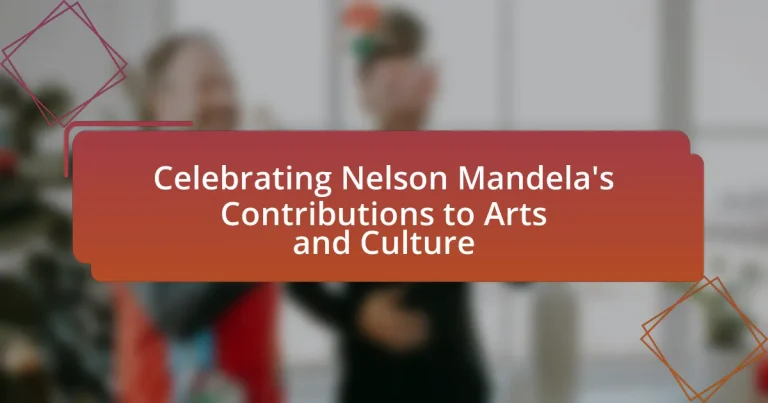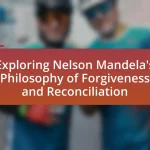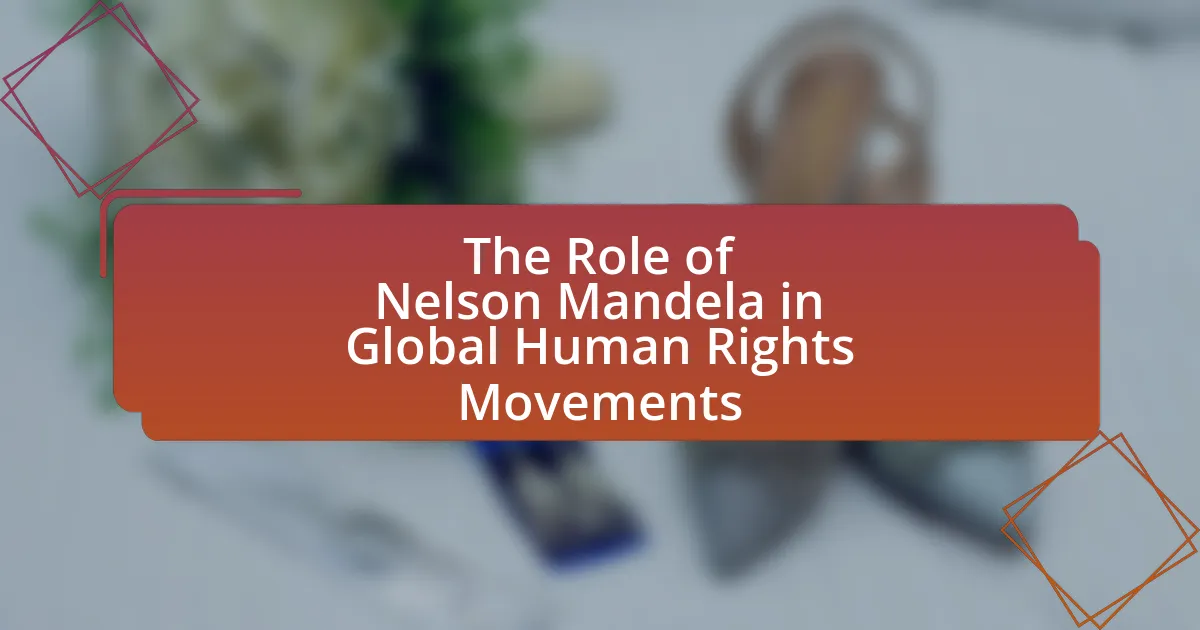Nelson Mandela’s contributions to arts and culture are significant in promoting South African identity and reconciliation, particularly post-apartheid. He recognized the arts as vital tools for unity and healing, supporting initiatives like the African Renaissance Conference and endorsing prominent artists. Mandela’s life experiences, including his long imprisonment, shaped his artistic vision, leading him to advocate for cultural expression as a means of resistance and empowerment. His policies fostered cultural diversity and provided funding opportunities for artists, while organizations he established, such as the Nelson Mandela Foundation, continue to support artistic endeavors that reflect his values of social justice and human rights.
What are Nelson Mandela’s key contributions to arts and culture?
Nelson Mandela’s key contributions to arts and culture include his promotion of South African music, literature, and visual arts as vital components of national identity and reconciliation. He recognized the power of the arts in fostering unity and healing post-apartheid, famously supporting initiatives like the 1996 African Renaissance Conference, which aimed to celebrate African culture and heritage. Mandela’s endorsement of artists such as Hugh Masekela and Miriam Makeba helped elevate their work on global platforms, showcasing South African culture to the world. Additionally, he established the Nelson Mandela Foundation, which supports cultural projects that reflect his values of social justice and human rights, further solidifying his legacy in the arts.
How did Mandela’s life experiences influence his artistic vision?
Nelson Mandela’s life experiences profoundly shaped his artistic vision, particularly through his commitment to social justice and human rights. His 27 years of imprisonment exposed him to the harsh realities of oppression, which fueled his desire to express the struggles of his people through art. Mandela’s interactions with various cultural movements during his life, including the African National Congress and his appreciation for traditional African art forms, further enriched his artistic perspective. For instance, his admiration for the works of South African artists and writers, who depicted the fight against apartheid, inspired him to advocate for art as a means of resistance and empowerment. This connection between his personal experiences and artistic expression highlights how Mandela viewed art as a powerful tool for social change and cultural identity.
What specific events shaped Mandela’s perspective on arts and culture?
Nelson Mandela’s perspective on arts and culture was significantly shaped by his experiences during the anti-apartheid struggle, particularly the influence of African cultural heritage and the role of artists in activism. Mandela recognized the power of music, literature, and visual arts as tools for resistance and unity, especially during his imprisonment, where he was inspired by the songs and writings of fellow activists. The 1960 Sharpeville Massacre, which highlighted the brutality of apartheid, also reinforced his belief in the importance of cultural expression as a means of raising awareness and fostering solidarity among oppressed communities. Additionally, Mandela’s interactions with international artists and cultural figures during his time in exile further broadened his appreciation for the arts as a vehicle for social change and reconciliation in post-apartheid South Africa.
How did his imprisonment impact his views on creativity?
Nelson Mandela’s imprisonment profoundly shaped his views on creativity, leading him to see it as a vital tool for resistance and social change. During his 27 years in prison, Mandela engaged with literature, music, and art, which reinforced his belief that creativity could inspire hope and mobilize communities against oppression. He recognized that artistic expression served as a means to communicate the struggles of the oppressed and foster solidarity. This perspective is evident in his later support for cultural initiatives that promoted freedom of expression and the arts as essential components of a democratic society.
Why is arts and culture significant in Mandela’s legacy?
Arts and culture are significant in Mandela’s legacy because they served as vital tools for social change and unity in South Africa. Mandela recognized the power of artistic expression to inspire hope and foster reconciliation during the country’s transition from apartheid to democracy. He supported initiatives that promoted cultural diversity and encouraged the arts as a means of healing and building a cohesive society. For instance, the establishment of the Nelson Mandela Foundation emphasizes the importance of arts in promoting human rights and social justice, reflecting Mandela’s belief that culture can bridge divides and empower communities.
What role did arts play in the anti-apartheid movement?
Arts played a crucial role in the anti-apartheid movement by serving as a powerful medium for resistance and expression. Artists, musicians, and writers used their work to raise awareness about the injustices of apartheid, mobilize support, and foster a sense of unity among oppressed communities. For instance, the song “Free Nelson Mandela” by the Special AKA became an anthem for the movement, highlighting the struggle against racial oppression and galvanizing international support. Additionally, visual arts, such as the works of artists like Willie Bester, depicted the harsh realities of apartheid, influencing public perception and encouraging activism. Through these creative expressions, arts not only documented the struggle but also inspired hope and resilience among those fighting for freedom and equality.
How did Mandela promote cultural expression in South Africa?
Nelson Mandela promoted cultural expression in South Africa by advocating for the recognition and celebration of diverse cultural identities and traditions. He emphasized the importance of arts and culture as tools for social cohesion and national unity, particularly during the transition from apartheid to democracy. Mandela supported initiatives such as the establishment of the Nelson Mandela Foundation, which promotes cultural heritage and artistic expression, and he encouraged the inclusion of various cultural forms in national celebrations, such as the annual Nelson Mandela International Day. His leadership in promoting events like the 1995 Rugby World Cup also showcased South African culture on a global stage, fostering a sense of pride and unity among its people.
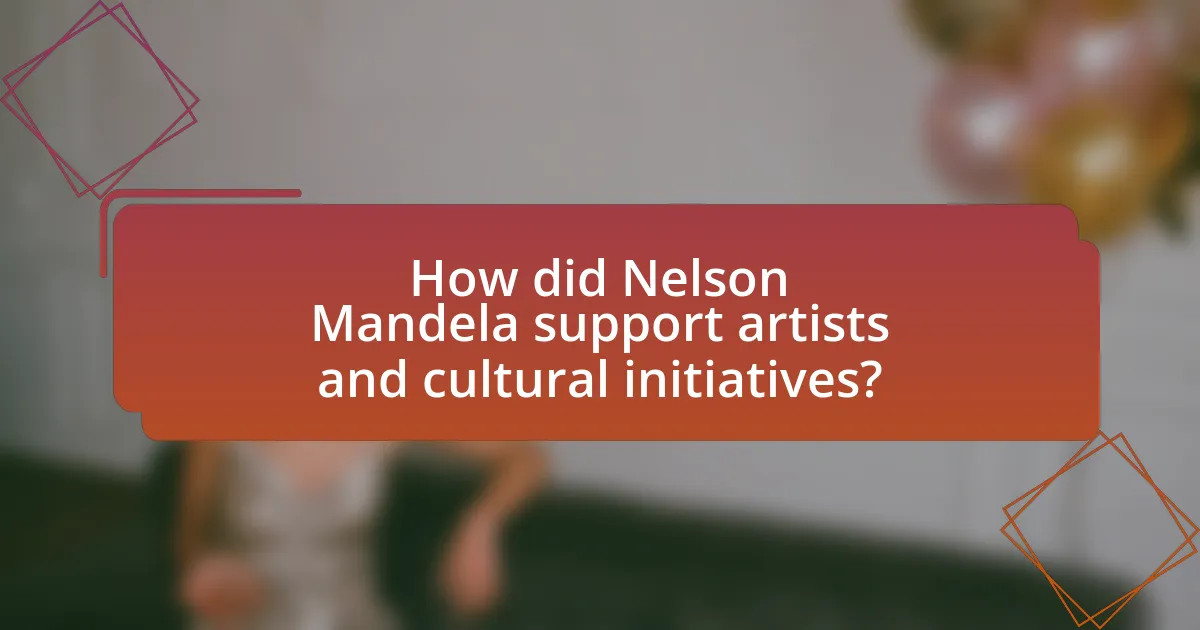
How did Nelson Mandela support artists and cultural initiatives?
Nelson Mandela supported artists and cultural initiatives by promoting freedom of expression and advocating for the arts as a means of social change. He recognized the importance of culture in the struggle against apartheid and encouraged artistic endeavors that reflected the diverse South African identity. Mandela’s establishment of the Nelson Mandela Foundation in 1999 further facilitated support for artists through grants and initiatives aimed at preserving cultural heritage. His participation in events like the 1995 Rugby World Cup and the 1996 Arts and Culture Conference showcased his commitment to uniting the nation through cultural expression.
What organizations did Mandela establish or support for the arts?
Nelson Mandela established and supported several organizations for the arts, including the Nelson Mandela Foundation, which promotes arts and culture as part of its mission to foster social justice and human rights. Additionally, Mandela supported the African Cultural Development Foundation, aimed at promoting African arts and culture. His advocacy for the arts was evident in his efforts to encourage creativity and expression among South African artists, particularly during the post-apartheid era, emphasizing the importance of arts in nation-building and reconciliation.
How did these organizations impact local artists?
These organizations significantly impacted local artists by providing platforms for exposure, funding opportunities, and resources for artistic development. For instance, initiatives like the Nelson Mandela Foundation have supported local art exhibitions and cultural festivals, which showcase the work of emerging artists. Additionally, grants and mentorship programs offered by these organizations have enabled artists to refine their skills and gain recognition in both local and international markets. This support has led to increased visibility and economic opportunities for local artists, fostering a vibrant arts community that honors Mandela’s legacy in promoting cultural expression.
What initiatives were launched to promote cultural heritage?
Initiatives launched to promote cultural heritage include the establishment of the Nelson Mandela Foundation, which focuses on preserving Mandela’s legacy and promoting arts and culture. The foundation organizes events, exhibitions, and educational programs that highlight South Africa’s diverse cultural heritage. Additionally, the “Mandela Day” initiative encourages global citizens to engage in community service, fostering cultural exchange and understanding. These initiatives are supported by various partnerships with cultural institutions and local communities, ensuring a broad impact on cultural heritage preservation and promotion.
In what ways did Mandela’s policies influence the arts sector?
Mandela’s policies significantly influenced the arts sector by promoting cultural diversity and supporting artistic expression as a means of reconciliation. His government established initiatives like the National Arts Council in 1997, which provided funding and resources to artists from various backgrounds, fostering a more inclusive arts environment. Additionally, Mandela’s emphasis on freedom of expression encouraged artists to address social issues, leading to a vibrant cultural scene that reflected the nation’s struggles and triumphs. This approach not only revitalized the arts but also positioned them as essential tools for nation-building and healing post-apartheid South Africa.
What funding opportunities were created for artists post-apartheid?
Post-apartheid, several funding opportunities were established for artists in South Africa, significantly enhancing their ability to create and showcase their work. The National Arts Council (NAC) was formed to provide financial support and resources to artists and arts organizations, facilitating various projects and initiatives. Additionally, the Arts and Culture Trust (ACT) was created to promote and fund arts and culture projects, ensuring that diverse artistic expressions are supported. These institutions have played a crucial role in fostering a vibrant arts scene, reflecting the democratic values championed by Nelson Mandela.
How did Mandela’s government address cultural diversity in the arts?
Mandela’s government addressed cultural diversity in the arts by promoting inclusive policies that recognized and celebrated the various cultural heritages of South Africa. The establishment of the Department of Arts and Culture in 1994 aimed to foster a national identity that embraced the country’s diverse cultural expressions. This initiative included funding for arts programs that represented different ethnic groups, support for cultural festivals, and the promotion of multilingualism in artistic expressions. Additionally, the government encouraged the participation of historically marginalized communities in the arts, ensuring that their voices and stories were represented in national narratives.
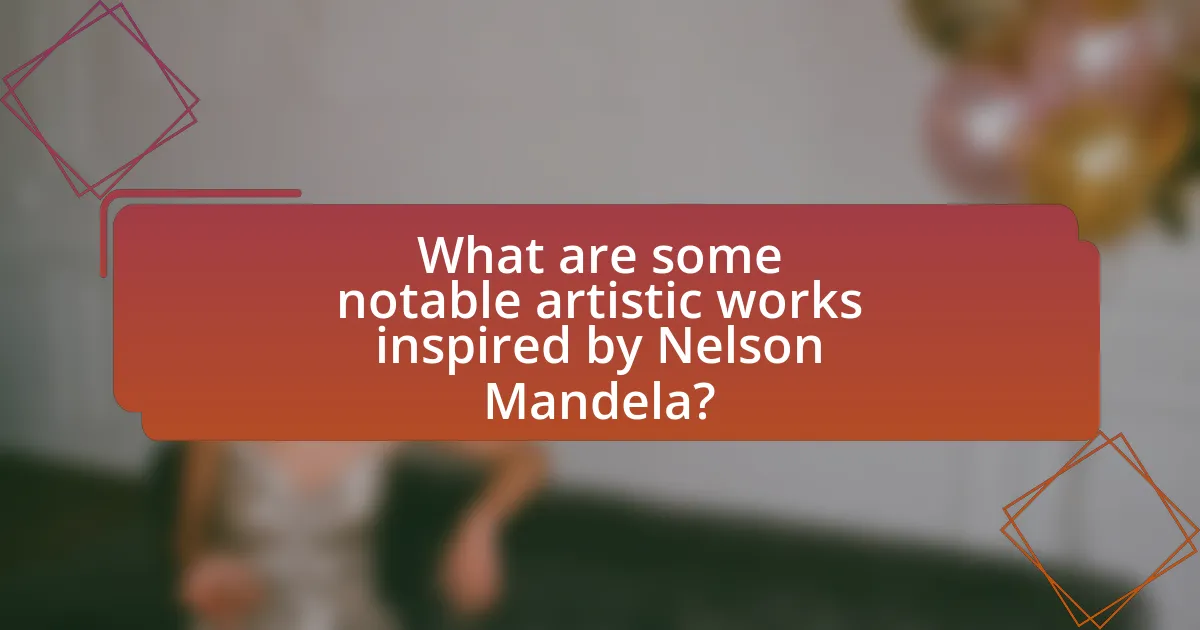
What are some notable artistic works inspired by Nelson Mandela?
Notable artistic works inspired by Nelson Mandela include the opera “Mandela: The Opera,” which premiered in 2010 and portrays his life and struggles against apartheid. Additionally, the film “Invictus,” directed by Clint Eastwood and released in 2009, depicts Mandela’s efforts to unite South Africa through rugby. The song “Nelson Mandela” by the band The Special A.K.A. became an anthem for the anti-apartheid movement, highlighting his influence on music and culture. Furthermore, the artwork “The Long Walk to Freedom” by artist Paul Blomkamp captures Mandela’s journey and legacy. These works collectively reflect Mandela’s profound impact on the arts and culture, celebrating his fight for justice and equality.
Which artists have created works in honor of Mandela?
Numerous artists have created works in honor of Nelson Mandela, including prominent figures such as William Kentridge, who produced animated films and installations reflecting Mandela’s legacy, and the South African artist Esther Mahlangu, known for her vibrant Ndebele art that celebrates cultural heritage linked to Mandela’s vision for unity. Additionally, the renowned street artist Banksy created a mural titled “Madiba,” which pays tribute to Mandela’s impact on social justice. These artists contribute to a broader cultural dialogue that recognizes Mandela’s influence on art and society.
What themes are prevalent in these artistic expressions?
Prevalent themes in artistic expressions celebrating Nelson Mandela’s contributions to arts and culture include resilience, freedom, and social justice. These themes reflect Mandela’s enduring spirit in the face of adversity, his lifelong struggle against apartheid, and his advocacy for equality and human rights. For instance, artworks often depict the fight for liberation and the importance of cultural identity, illustrating how Mandela’s legacy inspires artists to address contemporary social issues. Additionally, the theme of unity is frequently represented, emphasizing Mandela’s vision of reconciliation and harmony among diverse communities.
How have these works contributed to Mandela’s legacy?
Mandela’s works have significantly contributed to his legacy by promoting social justice, equality, and cultural expression. His involvement in the arts, including literature and music, has inspired global movements for human rights and has fostered a deeper understanding of the struggles against apartheid. For instance, Mandela’s support for artists and cultural initiatives, such as the establishment of the Nelson Mandela Foundation, has preserved his vision of a united and equitable society. This foundation actively promotes arts and culture as tools for social change, reinforcing Mandela’s belief in the transformative power of creativity.
How has Mandela’s influence extended to global arts and culture?
Mandela’s influence has significantly extended to global arts and culture by inspiring artists and cultural movements worldwide to advocate for social justice and human rights. His life and legacy have been depicted in various forms of art, including literature, music, and visual arts, which reflect themes of resilience, freedom, and equality. For instance, the song “Free Nelson Mandela” by The Special A.K.A. became an anthem for the anti-apartheid movement, highlighting how his struggle resonated globally. Additionally, numerous films and documentaries, such as “Mandela: Long Walk to Freedom,” have portrayed his journey, further embedding his ideals into the cultural consciousness. Mandela’s emphasis on reconciliation and unity has also influenced global art initiatives, promoting collaborative projects that bridge cultural divides, thereby reinforcing his impact on the arts and culture landscape worldwide.
What international collaborations have emerged in his name?
International collaborations that have emerged in Nelson Mandela’s name include the Nelson Mandela Foundation, which partners with various global organizations to promote social justice and human rights. Additionally, the Mandela Day initiative encourages people worldwide to engage in community service, fostering international cooperation. These collaborations are supported by numerous events and projects that celebrate Mandela’s legacy, such as the annual Mandela International Day, recognized by the United Nations, which mobilizes individuals and organizations to take action for social change.
How do global artists interpret Mandela’s message through their work?
Global artists interpret Mandela’s message through their work by embodying themes of freedom, equality, and social justice. For instance, visual artists like Ai Weiwei and Kehinde Wiley create pieces that reflect Mandela’s fight against oppression and his advocacy for human rights, often using symbolism that resonates with struggles for liberation worldwide. Musicians such as Bono and the late Hugh Masekela have incorporated Mandela’s ideals into their lyrics and performances, emphasizing unity and resilience. These interpretations are validated by Mandela’s own words, which emphasize the importance of art in inspiring change and fostering dialogue, as seen in his speeches and writings that highlight the transformative power of creativity in social movements.
What practical steps can individuals take to celebrate Mandela’s contributions to arts and culture?
Individuals can celebrate Mandela’s contributions to arts and culture by participating in local cultural events that honor his legacy. Engaging in activities such as attending exhibitions, performances, or film screenings that highlight South African art and history directly reflects Mandela’s influence on the arts. For instance, the Nelson Mandela Foundation organizes various cultural initiatives that promote artistic expression and social justice, showcasing how his life and work continue to inspire creativity. Additionally, individuals can support local artists and cultural organizations that align with Mandela’s values, thereby fostering a community that appreciates and promotes the arts in a manner consistent with his vision for equality and cultural richness.
How can communities engage in cultural events honoring Mandela?
Communities can engage in cultural events honoring Mandela by organizing festivals, art exhibitions, and educational programs that reflect his values and contributions. These events can include performances of traditional music and dance, showcasing South African culture, and discussions on Mandela’s impact on social justice and human rights. For instance, the annual Nelson Mandela International Day on July 18 encourages community service and cultural activities that promote his legacy, emphasizing the importance of collective action and social responsibility.
What resources are available for learning about Mandela’s impact on the arts?
Resources available for learning about Nelson Mandela’s impact on the arts include books, documentaries, and academic articles. Notable books such as “Mandela: The Authorised Biography” by Anthony Sampson provide insights into his life and influence on various art forms. Documentaries like “Mandela: Long Walk to Freedom” explore his legacy, including his support for artists and cultural initiatives. Academic articles, such as those found in journals like “African Arts,” analyze the intersection of his political activism and the arts, highlighting specific examples of artists inspired by his work. These resources collectively illustrate Mandela’s profound influence on the arts and culture.
